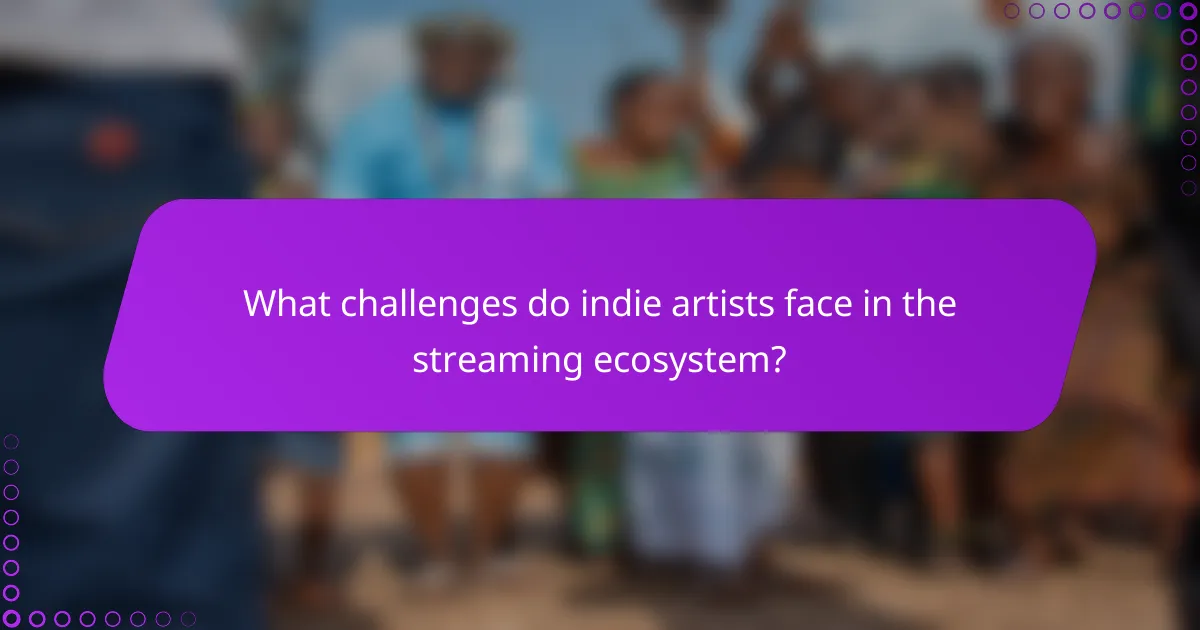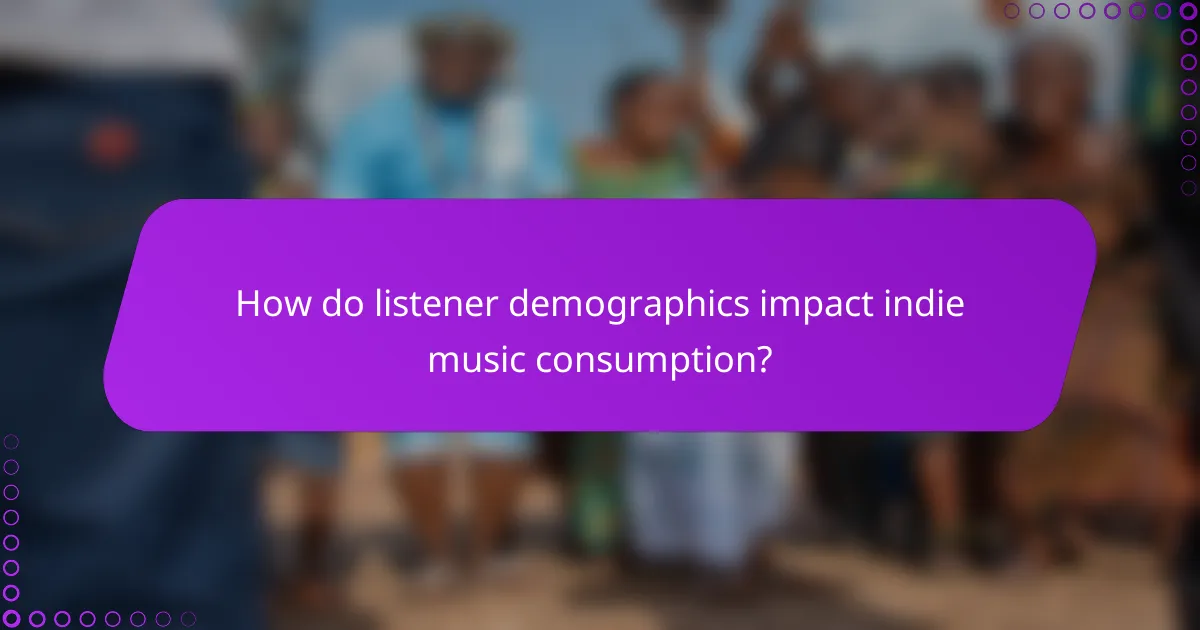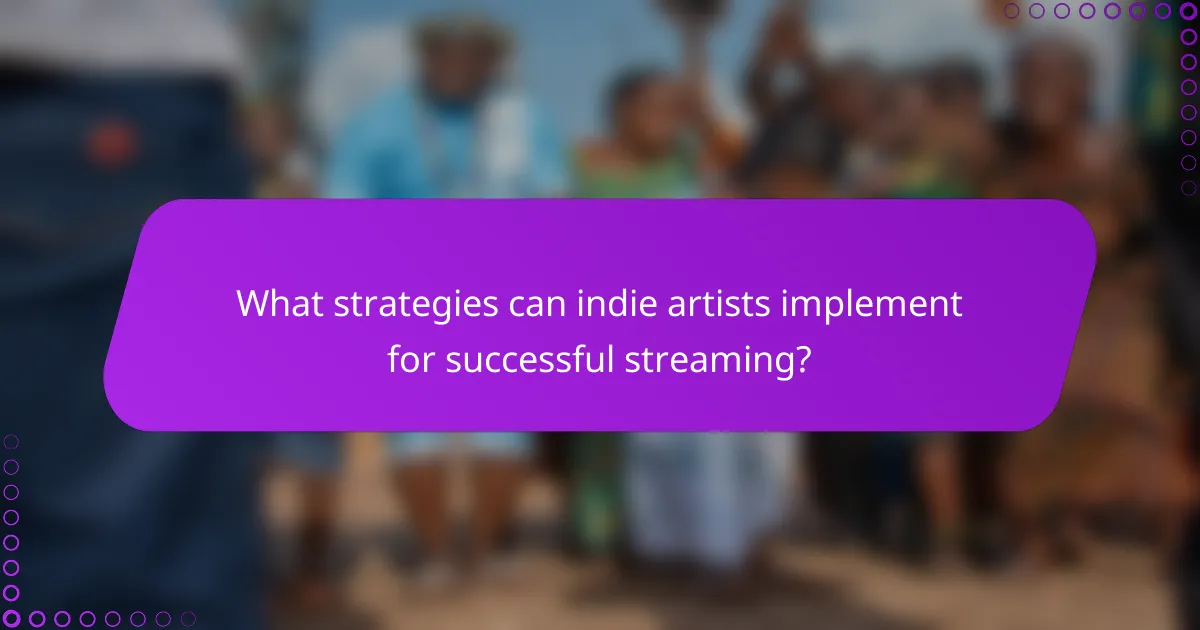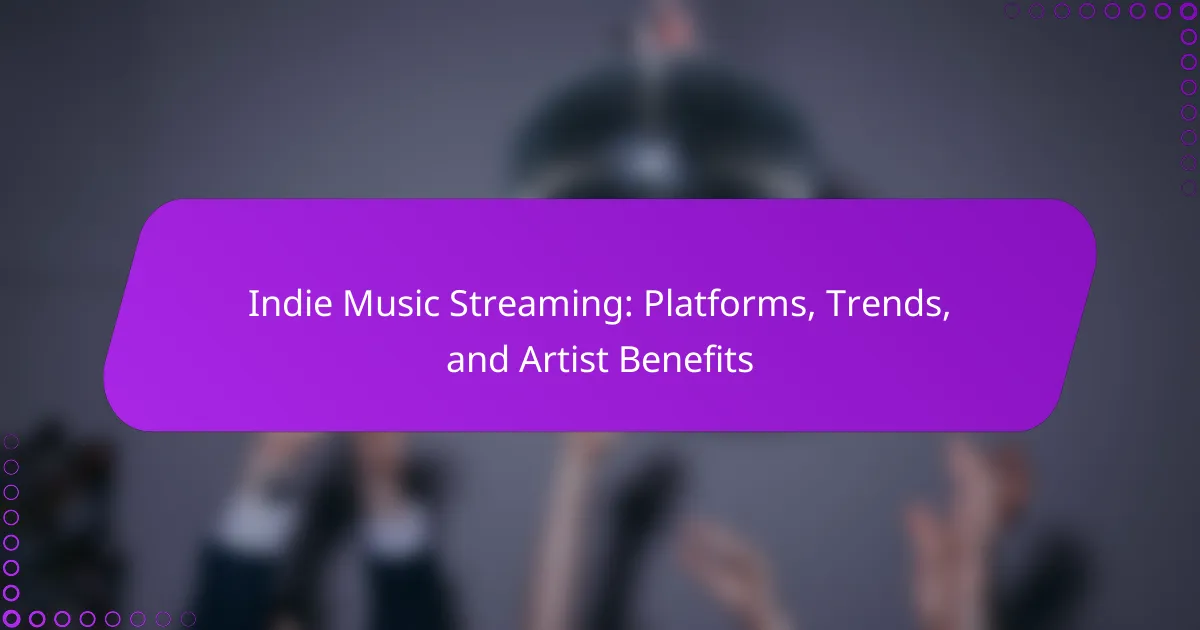Indie music streaming offers artists exposure and revenue but presents challenges like competition and low payouts. Key platforms include Spotify, Apple Music, and Bandcamp, each providing unique benefits. Trends show personalization and data analytics enhancing listener engagement. Understanding demographics and implementing targeted strategies can help indie artists succeed in this evolving landscape.

Which platforms dominate the indie music streaming landscape?
Spotify, Apple Music, and Bandcamp dominate the indie music streaming landscape. These platforms offer unique features that cater to independent artists and their audiences.
Spotify leads with its extensive user base and algorithm-driven playlists, promoting indie tracks widely. Apple Music provides high-quality audio and exclusive artist content, appealing to audiophiles. Bandcamp stands out for its direct artist support model, allowing creators to set prices and retain a larger share of revenue.
Emerging platforms like SoundCloud and Tidal are also gaining traction, offering unique benefits such as community engagement and high-fidelity sound. The indie music streaming landscape continues to evolve, driven by artist needs and listener preferences.
How do user preferences vary across different streaming services?
User preferences for indie music streaming vary significantly across platforms. Factors such as user interface, music discovery features, and exclusive content influence these preferences. For example, Spotify excels in personalized playlists, while Bandcamp offers direct artist support and unique releases. Apple Music attracts users with its curated content and integration with other Apple services. Understanding these differences helps artists choose the right platform to reach their audience effectively.
What are the key features of popular indie music streaming platforms?
Popular indie music streaming platforms feature user-friendly interfaces, diverse music catalogs, and artist-centric revenue models. They often emphasize independent artists, offering tools for promotion and listener engagement. Key features include curated playlists, personalized recommendations, and social sharing capabilities. Some platforms provide unique attributes like exclusive content and direct artist support options, enhancing the overall user experience.
How do regional platforms influence indie music exposure?
Regional platforms significantly enhance indie music exposure by connecting local artists with targeted audiences. These platforms often prioritize regional genres and trends, allowing artists to gain traction within specific communities. For example, platforms like Bandcamp and SoundCloud have localized features that promote music based on geographic preferences, increasing visibility for indie artists. Additionally, regional platforms can provide unique promotional opportunities, such as local events and collaborations, fostering a deeper connection between artists and fans. This localized support is crucial for indie musicians seeking to build a dedicated listener base.

What trends are shaping the future of indie music streaming?
Indie music streaming is increasingly shaped by personalization, data analytics, and community engagement. Platforms are leveraging algorithms to curate tailored playlists that enhance user experience. As a result, artists gain insights into listener preferences, allowing them to refine their music strategies. Additionally, social media integration fosters direct connections between artists and fans, creating a supportive ecosystem for indie musicians. Streaming services are also prioritizing niche genres, ensuring diverse representation in the music landscape.
How is technology impacting indie music distribution?
Technology significantly enhances indie music distribution by providing accessible platforms and tools for artists. Streaming services like Spotify and Bandcamp empower independent musicians to reach global audiences without traditional gatekeepers. These platforms offer analytics, enabling artists to understand listener demographics and preferences, which informs their marketing strategies. Additionally, social media facilitates direct engagement with fans, fostering community and loyalty. Overall, technology democratizes music distribution, allowing indie artists to thrive in a competitive landscape.
What role does social media play in promoting indie artists?
Social media significantly enhances the visibility of indie artists. It provides platforms for direct engagement with fans, allowing artists to share music, behind-the-scenes content, and personal stories. This interaction fosters a loyal fan base and encourages sharing, which amplifies reach.
Platforms like Instagram, TikTok, and Twitter are pivotal in promoting new releases and upcoming shows. For instance, TikTok trends can propel songs to viral status, generating substantial streaming numbers. Additionally, social media analytics offer insights into audience preferences, helping artists tailor their marketing strategies effectively.
The unique attribute of social media is its ability to democratize music promotion, allowing indie artists to compete with mainstream acts without significant financial backing. This level playing field empowers creativity and innovation in marketing approaches.
Moreover, collaborations and cross-promotions on social media can introduce indie artists to new audiences, further expanding their reach. As a result, social media plays an essential role in the growth and sustainability of indie music careers.
Which genres are gaining traction on indie streaming platforms?
Genres gaining traction on indie streaming platforms include lo-fi, bedroom pop, and synthwave. These styles resonate with audiences seeking authentic and innovative sounds. Lo-fi music’s chill beats appeal to study and relaxation, while bedroom pop’s intimate production connects with personal storytelling. Synthwave’s nostalgic vibes attract fans of retro aesthetics.

What benefits do indie artists gain from streaming platforms?
Indie artists gain exposure, revenue, and audience engagement from streaming platforms. These platforms provide access to a global audience, allowing artists to reach listeners who may not discover them otherwise. Streaming services often offer analytics, helping artists understand their audience demographics and preferences. Additionally, many platforms have monetization options, including royalties and promotional tools, which can enhance an artist’s income and visibility. As a result, indie artists can build a sustainable career while maintaining creative control.
How does streaming revenue compare to traditional music sales?
Streaming revenue significantly surpasses traditional music sales in recent years. Streaming platforms have become the primary source of income for indie artists, shifting the industry landscape. In 2022, streaming accounted for over 80% of music industry revenue, while physical and digital sales declined.
The benefits for indie artists include broader reach and accessibility. Platforms like Spotify and Apple Music provide exposure to millions of listeners without the need for extensive marketing budgets. Additionally, streaming allows artists to earn revenue from plays, creating a more sustainable income model compared to one-time purchases from traditional sales.
As a result, the shift towards streaming has enabled indie artists to thrive in a competitive market, leveraging data analytics to understand listener preferences and enhance engagement. This evolution reflects a unique attribute of the modern music industry, emphasizing adaptability and innovation among artists.
What promotional tools are available for indie artists on streaming platforms?
Indie artists can utilize various promotional tools on streaming platforms, including social media integration, playlist placements, and direct fan engagement features. These tools enhance visibility and foster audience connections.
Social media integration allows artists to share their music easily, boosting discovery. Playlist placements on platforms like Spotify can significantly increase streams and reach. Direct fan engagement features, such as live Q&A sessions or exclusive content, help build a loyal fan base.
Additionally, analytics tools provide insights into listener demographics and behavior, enabling artists to tailor their promotional strategies effectively. These resources empower indie artists to navigate the competitive streaming landscape successfully.
How can indie artists leverage analytics from streaming services?
Indie artists can effectively leverage analytics from streaming services to enhance their music strategy. By analyzing listener demographics, artists can tailor their marketing efforts to specific audiences. Understanding streaming patterns helps in identifying popular tracks, guiding future releases. Additionally, engagement metrics reveal fan interactions, allowing artists to strengthen their connection with listeners. This data-driven approach supports informed decision-making, ultimately boosting an artist’s visibility and growth in the competitive music landscape.

What challenges do indie artists face in the streaming ecosystem?
Indie artists face significant challenges in the streaming ecosystem, primarily due to competition and revenue distribution. The oversaturation of platforms makes it difficult for new talent to gain visibility. Additionally, streaming services often provide minimal payouts per stream, impacting artists’ financial sustainability. With algorithms favoring established artists, indie musicians struggle to reach wider audiences. Furthermore, the lack of direct fan engagement tools limits their ability to build loyal followings.
How do payment structures affect indie artist earnings?
Payment structures significantly impact indie artist earnings by determining how much revenue artists receive per stream. Streaming platforms often use pro-rata or pay-per-stream models, affecting overall income. For instance, Spotify’s pro-rata system pools all subscription fees and distributes them based on market share, leading to lower per-stream payouts. In contrast, platforms like Bandcamp allow artists to set their own prices, resulting in higher earnings per sale. As a result, indie artists must choose platforms wisely to maximize their revenue potential.
What are the common pitfalls for indie artists in music streaming?
Indie artists in music streaming often face pitfalls such as lack of visibility, revenue challenges, and navigating platform algorithms. These issues can hinder their ability to reach audiences and monetize their work effectively.
One common pitfall is the oversaturation of content on major streaming platforms, making it difficult for indie artists to stand out. As a result, many struggle to gain traction despite high-quality music. Additionally, the revenue generated from streaming is typically low, which can limit financial sustainability for independent musicians.
Another challenge is the complexity of algorithms used by streaming services, which can favor established artists over newcomers. Indie artists may find it hard to understand how to optimize their presence on these platforms, resulting in missed opportunities for engagement and growth.
Lastly, the reliance on social media for promotion can lead to burnout and pressure to constantly create content outside of music, diverting focus from their primary artistic endeavors.

How do listener demographics impact indie music consumption?
Listener demographics significantly influence indie music consumption patterns. Younger audiences, particularly Millennials and Gen Z, favor streaming platforms like Spotify and Apple Music. These platforms provide personalized playlists and algorithm-driven recommendations, catering to diverse tastes. Additionally, regional demographics shape genre popularity; for example, urban listeners may lean towards electronic indie, while rural areas might prefer acoustic styles. Understanding these trends helps artists target their marketing effectively and engage with their audience.
Which age groups are most engaged with indie music streaming?
Adults aged 18 to 34 are the most engaged with indie music streaming. This age group actively seeks new sounds and supports emerging artists. Additionally, data shows that 60% of indie music listeners fall within this demographic. Engaging content and personalized playlists attract this audience, driving trends in indie music consumption.
How does cultural background influence music streaming habits?
Cultural background significantly shapes music streaming habits by influencing genre preferences and platform choices. For instance, listeners from diverse cultures may gravitate toward specific indie genres that resonate with their heritage. Additionally, regional trends affect the popularity of platforms; for example, certain streaming services may dominate in specific countries due to localized content and marketing strategies. As a result, artists can benefit from understanding these cultural nuances to tailor their music and marketing efforts effectively.

What strategies can indie artists implement for successful streaming?
Indie artists can implement targeted strategies to enhance their streaming success. Focus on building a strong online presence through social media engagement and consistent content sharing.
Utilize platforms like Spotify and Apple Music for playlist placements, which can significantly increase visibility. Collaborate with other artists to tap into their audiences and expand reach.
Leverage data analytics from streaming services to understand listener demographics and preferences, allowing for tailored marketing efforts. Consider utilizing music videos and live streams to create engaging content that resonates with fans.
Invest in digital marketing campaigns to promote new releases, ensuring to highlight unique attributes that differentiate the music.
Which marketing techniques are effective for indie music promotion?
Effective marketing techniques for indie music promotion include social media engagement, playlist placements, and live performances. These strategies enhance visibility and connect artists with audiences.
Social media platforms like Instagram and TikTok allow artists to share their music and personal stories, fostering a loyal fanbase. Playlist placements on streaming services can significantly increase streams and attract new listeners. Live performances create memorable experiences and help build a community around the artist.
Collaborations with other artists can expand reach and introduce music to new audiences. Email marketing remains a powerful tool for direct communication, offering fans exclusive content and updates.
Utilizing data analytics can help artists understand their audience and tailor their promotional efforts effectively.
How can collaborations enhance visibility for indie artists?
Collaborations enhance visibility for indie artists by expanding their audience reach through shared fan bases. When artists collaborate, they tap into each other’s networks, increasing exposure and engagement. Collaborations can also lead to unique content that attracts attention, such as joint performances or cross-promotional social media campaigns. Moreover, partnerships with established artists can lend credibility and draw new listeners, significantly benefiting indie artists in a competitive digital landscape.
What are the best practices for building a loyal listener base?
To build a loyal listener base in indie music streaming, focus on engagement, authenticity, and community building. Regularly interact with fans through social media and live events to foster a sense of connection. Offer exclusive content, such as behind-the-scenes footage or early access to new releases, to create value. Collaborate with other artists to reach new audiences and leverage their fan bases. Consistency in releasing music and maintaining a strong brand identity will also help retain listeners.
